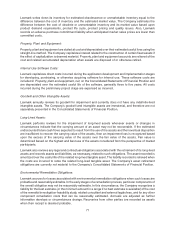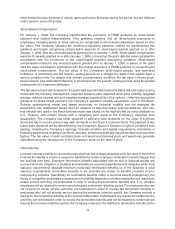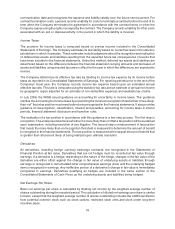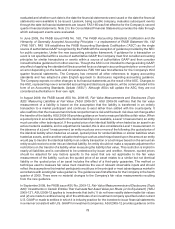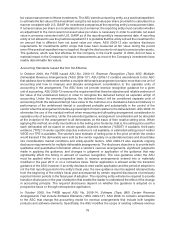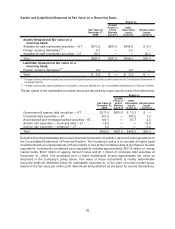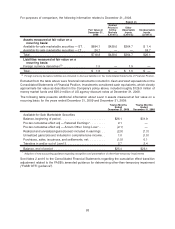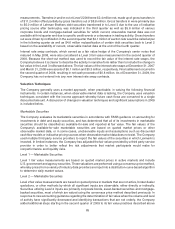Lexmark 2009 Annual Report Download - page 81
Download and view the complete annual report
Please find page 81 of the 2009 Lexmark annual report below. You can navigate through the pages in the report by either clicking on the pages listed below, or by using the keyword search tool below to find specific information within the annual report.communication date and recognizes the expense and liability ratably over the future service period. For
contract termination costs, Lexmark records a liability for costs to terminate a contract before the end of its
term when the Company terminates the agreement in accordance with the contract terms or when the
Company ceases using the rights conveyed by the contract. The Company records a liability for other costs
associated with an exit or disposal activity in the period in which the liability is incurred.
Income Taxes:
The provision for income taxes is computed based on pre-tax income included in the Consolidated
Statements of Earnings. The Company estimates its tax liability based on current tax laws in the statutory
jurisdictions in which it operates. These estimates include judgments about the recognition and realization
of deferred tax assets and liabilities resulting from the expected future tax consequences of events that
have been included in the financial statements. Under this method, deferred tax assets and liabilities are
determined based on the difference between the financial statement carrying amounts and tax bases of
assets and liabilities using enacted tax rates in effect for the year in which the differences are expected to
reverse.
The Company determines its effective tax rate by dividing its income tax expense by its income before
taxes as reported in its Consolidated Statements of Earnings. For reporting periods prior to the end of the
Company’s fiscal year, the Company records income tax expense based upon an estimated annual
effective tax rate. This rate is computed using the statutory tax rate and an estimate of annual net income
by geographic region adjusted for an estimate of non-deductible expenses and available tax credits.
In July 2006, the FASB issued guidance on accounting for uncertainty in income taxes. This guidance
clarifies the accounting for income taxes by prescribing the minimum recognition threshold as “more-likely-
than-not” that a tax position must meet before being recognized in the financial statements. It also provides
guidance on derecognition, classification, interest and penalties, accounting for income taxes in interim
periods, financial statement disclosure and transition rules.
The evaluation of a tax position in accordance with this guidance is a two-step process. The first step is
recognition: The enterprise determines whether it is more likely than not that a tax position will be sustained
upon examination, including resolution of any litigation. The second step is measurement: A tax position
that meets the more-likely-than-not recognition threshold is measured to determine the amount of benefit
to recognize in the financial statements. The tax position is measured at the largest amount of benefit that
is greater than 50 percent likely of being realized upon ultimate resolution.
Derivatives:
All derivatives, including foreign currency exchange contracts, are recognized in the Statements of
Financial Position at fair value. Derivatives that are not hedges must be recorded at fair value through
earnings. If a derivative is a hedge, depending on the nature of the hedge, changes in the fair value of the
derivative are either offset against the change in fair value of underlying assets or liabilities through
earnings or recognized in Accumulated other comprehensive earnings (loss) until the underlying hedged
item is recognized in earnings. Any ineffective portion of a derivative’s change in fair value is immediately
recognized in earnings. Derivatives qualifying as hedges are included in the same section of the
Consolidated Statements of Cash Flows as the underlying assets and liabilities being hedged.
Net Earnings Per Share:
Basic net earnings per share is calculated by dividing net income by the weighted average number of
shares outstanding during the reported period. The calculation of diluted net earnings per share is similar
to basic, except that the weighted average number of shares outstanding includes the additional dilution
from potential common stock such as stock options, restricted stock units and stock under long-term
incentive plans.
75








